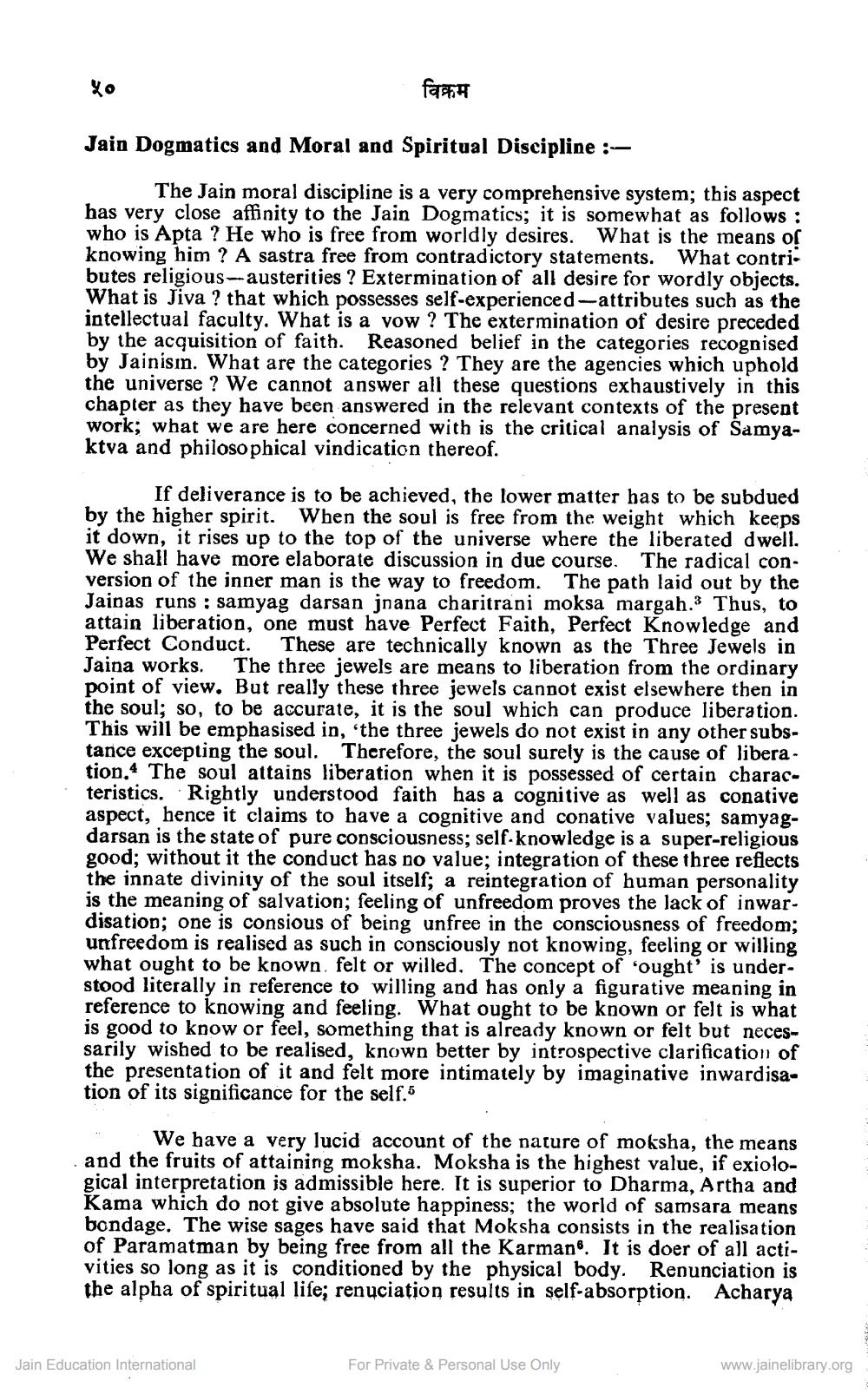________________
विक्रम
Jain Dogmatics and Moral and Spiritual Discipline :
The Jain moral discipline is a very comprehensive system; this aspect has very close affinity to the Jain Dogmatics; it is somewhat as follows: who is Apta ? He who is free from worldly desires. What is the means of knowing him ? A sastra free from contradictory statements. What contributes religious-austerities ? Extermination of all desire for wordly objects. What is Jiva ? that which possesses self-experienced-attributes such as the intellectual faculty. What is a vow ? The extermination of desire preceded by the acquisition of faith. Reasoned belief in the categories recognised by Jainisin. What are the categories ? They are the agencies which uphold the universe? We cannot answer all these questions exhaustively in this chapter as they have been answered in the relevant contexts of the present work; what we are here concerned with is the critical analysis of Samyaktva and philosophical vindication thereof.
If deliverance is to be achieved, the lower matter has to be subdued by the higher spirit. When the soul is free from the weight which keeps it down, it rises up to the top of the universe where the liberated dwell. We shall have more elaborate discussion in due course. The radical conversion of the inner man is the way to freedom. The path laid out by the Jainas runs : samyag darsan jnana charitrani moksa margah.3 Thus, to attain liberation, one must have Perfect Faith, Perfect Knowledge and Perfect Conduct. These are technically known as the Three Jewels in Jaina works. The three jewels are means to liberation from the ordinary point of view. But really these three jewels cannot exist elsewhere then in the soul; so, to be accurate, it is the soul which can produce liberation. This will be emphasised in, 'the three jewels do not exist in any other substance excepting the soul. Therefore, the soul surely is the cause of liberation.4 The soul attains liberation when it is possessed of certain characteristics. Rightly understood faith has a cognitive as well as conative aspect, hence it claims to have a cognitive and conative values; samyagdarsan is the state of pure consciousness; self-knowledge is a super-religious good; without it the conduct has no value; integration of these three reflects the innate divinity of the soul itself; a reintegration of human personality is the meaning of salvation; feeling of unfreedom proves the lack of inwardisation; one is consious of being unfree in the consciousness of freedom; unfreedom is realised as such in consciously not knowing, feeling or willing what ought to be known felt or willed. The concept of 'ought' is understood literally in reference to willing and has only a figurative meaning in reference to knowing and feeling. What ought to be known or felt is what is good to know or feel, something that is already known or felt but necessarily wished to be realised, known better by introspective clarification of the presentation of it and felt more intimately by imaginative inwardisation of its significance for the self.5
We have a very lucid account of the nature of moksha, the means and the fruits of attaining moksha. Moksha is the highest value, if exiological interpretation is admissible here. It is superior to Dharma, Artha and Kama which do not give absolute happiness; the world of samsara means bondage. The wise sages have said that Moksha consists in the realisation of Paramatman by being free from all the Karman. It is doer of all activities so long as it is conditioned by the physical body. Renunciation is the alpha of spiritual life; renuciation results in self-absorption. Acharya
Jain Education International
For Private & Personal Use Only
www.jainelibrary.org




